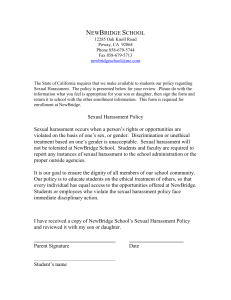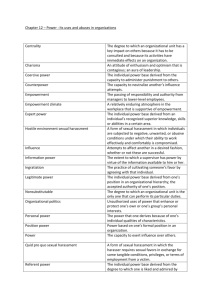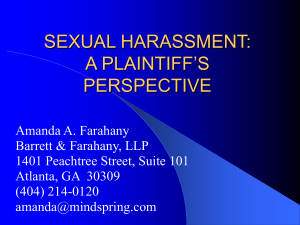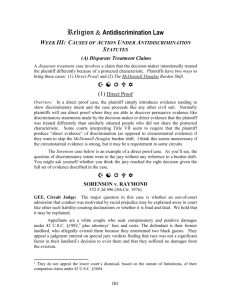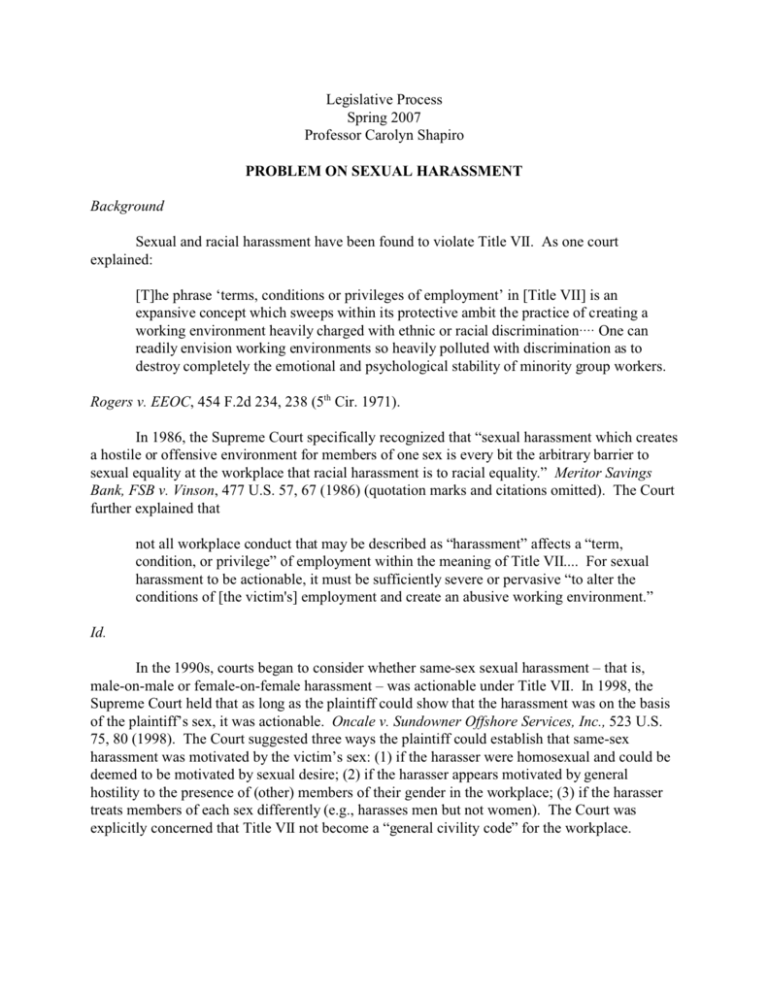
Legislative Process
Spring 2007
Professor Carolyn Shapiro
PROBLEM ON SEXUAL HARASSMENT
Background
Sexual and racial harassment have been found to violate Title VII. As one court
explained:
[T]he phrase ‘terms, conditions or privileges of employment’ in [Title VII] is an
expansive concept which sweeps within its protective ambit the practice of creating a
working environment heavily charged with ethnic or racial discriminationAAAA One can
readily envision working environments so heavily polluted with discrimination as to
destroy completely the emotional and psychological stability of minority group workers.
Rogers v. EEOC, 454 F.2d 234, 238 (5th Cir. 1971).
In 1986, the Supreme Court specifically recognized that “sexual harassment which creates
a hostile or offensive environment for members of one sex is every bit the arbitrary barrier to
sexual equality at the workplace that racial harassment is to racial equality.” Meritor Savings
Bank, FSB v. Vinson, 477 U.S. 57, 67 (1986) (quotation marks and citations omitted). The Court
further explained that
not all workplace conduct that may be described as “harassment” affects a “term,
condition, or privilege” of employment within the meaning of Title VII.... For sexual
harassment to be actionable, it must be sufficiently severe or pervasive “to alter the
conditions of [the victim's] employment and create an abusive working environment.”
Id.
In the 1990s, courts began to consider whether same-sex sexual harassment – that is,
male-on-male or female-on-female harassment – was actionable under Title VII. In 1998, the
Supreme Court held that as long as the plaintiff could show that the harassment was on the basis
of the plaintiff’s sex, it was actionable. Oncale v. Sundowner Offshore Services, Inc., 523 U.S.
75, 80 (1998). The Court suggested three ways the plaintiff could establish that same-sex
harassment was motivated by the victim’s sex: (1) if the harasser were homosexual and could be
deemed to be motivated by sexual desire; (2) if the harasser appears motivated by general
hostility to the presence of (other) members of their gender in the workplace; (3) if the harasser
treats members of each sex differently (e.g., harasses men but not women). The Court was
explicitly concerned that Title VII not become a “general civility code” for the workplace.
Problem
Consider the following scenario:
Plaintiff Gerald Smith is a member of an 8-person, all male crew on an oil platform in the
Gulf of Mexico. He is gay, but he has never discussed his sexual orientation at work or with his
co-workers. Through a string of coincidences related to a mutual friend who is not a co-worker,
one of Smith’s co-workers discovers that Smith is homosexual and shares that information with
the rest of the crew. From that point on, Smith is subjected to brutal harassment, including but
not limited to, threats of rape and physical assault, having his safety equipment sabotaged,
epithets like “homo,” “fem,” and worse written on his locker, and on several occasions, goosing
and other offensive touching in the shower. Smith is suing for sexual harassment under Title
VII. His employer argues that he is really suing for sexual orientation harassment, which is not
actionable under Title VII.
You are the judge in this case. How do you rule? How do you take account of the text of
the statute, the legislative history, including the “vetogates,” the “spirit” and overall purpose of
the Act, Supreme Court precedent, and contemporary understandings about discrimination?







